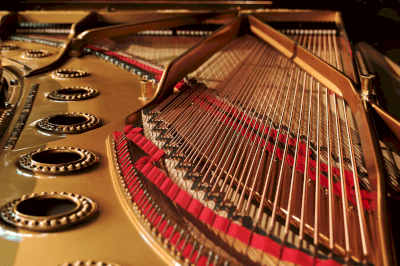What Is Piano Wire?
 Piano Wire is a type of high-tensile steel wire.
Piano Wire is a type of high-tensile steel wire.
It is used in a wide range of applications, including wire and various spring materials in the automotive and electronics fields, cables used in suspension bridges, bed springs, and prestressed concrete.
Uses of Piano Wire
1. Wire in the Automotive and Electronics Fields
Wires for opening and closing rear hatch of automobiles, voice coils of speakers, etc.
2. Various Spring Materials
Springs for automobile suspensions and seats, springs for industrial machinery, etc.
Piano wire is sometimes used as springs for industrial machinery in the following places:
Arm springs of hydraulic excavators
Arm springs of hydraulic excavators are used to support the arms of hydraulic excavators. Piano wire is used to produce arm springs that have high strength and durability and are not easily deformed even after long use.
Tension Adjustment Springs for Rolling Mills
Tension adjustment springs are required in rolling mills when processing thin metal sheets. By using piano wire, we can manufacture springs with high strength and accurate tension adjustment.
Heddle springs for looms
In a loom, heddle springs are essential parts for loom operation. By using piano wire, springs can be manufactured that have high strength and durability, and that do not deform even after long periods of use.
The heddle spring of a loom is the part that opens and closes the threads of the yarn. In a loom, warp and weft yarns cross each other to make fabric, which requires the warp yarns to move up and down at regular intervals. The heddle spring controls this movement and is essential for the accurate operation of the loom.
Printer pick-up roller spring
The pick-up roller spring of a printer is a part for capturing paper. Piano wire is used to produce springs that have high strength and can withstand the load of the rollers rotating at high speed.
3. Structural Components
Examples include cables used in suspension bridges, highway safety fences, and prestressed concrete.
Prestressed concrete is a type of reinforced concrete in which high-tensile steel wires and cables pre-tensioned to the structure and precompressed to minimize deformation due to subsequent loading and stress. By applying compressive forces in advance, the concrete exhibits higher strength, making structures such as large-span bridges and skyscrapers safer and lighter.
4. Everyday Items
Examples include bed springs and bicycle brake wires.
5. Other
Reinforcing material for power line wires, etc.
Properties of Piano Wire
1. High Tensile Strength
The reason for the high tensile strength of piano wire lies in the manufacturing process. Piano wire is made from high-quality steel material and manufactured through the drawing and quenching processes.
Drawing is a process by which metal wire is stretched to produce a thin, uniform wire rod. By drawing metal wire through a metal mold, the wire can be made uniformly thin. It is the process of drawing steel wire out of a die to produce uniformly thin wire with a fine diameter. Wires produced by drawing have a uniform structure and are characterized by high strength.
Quenching heats iron wire in a high-temperature environment and then quenches it, giving the wire elasticity and strength. The heat expands the iron wire, and the rapid cooling causes it to contract, resulting in a stronger wire.
2. High Durability
Piano wire is highly durable, and quenching at high temperatures further improves its durability.
Piano wire is made of high quality steel material, and drawing and quenching during the manufacturing process allows piano wire to withstand very high tensile forces. They have excellent corrosion resistance and are resistant to rust, so they do not deteriorate easily even after long-term use.
Quenching is the process of heating piano wire in a high-temperature environment and then cooling it rapidly to give the wire elasticity and strength. Quenching at high temperatures improves the crystal structure of piano wire and forms a stronger structure. This improves the durability of piano wire and allows it to withstand use for a longer period of time. Quenching also hardens the surface of the piano wire and makes it more resistant to wear and tear, so it is less likely to deteriorate even if worn during use.